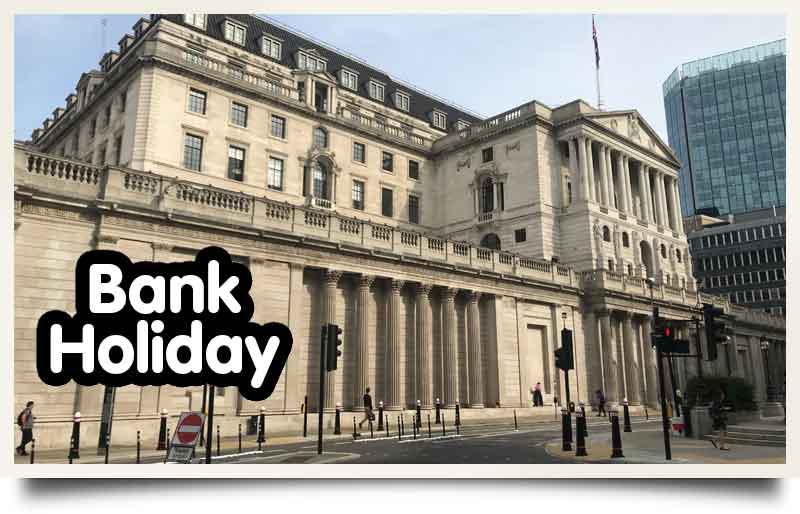Bank of England London Private Guided Tours

The Bank of England is the central bank of the United Kingdom - a model that has been adopted by most central banks in modern times and is one of eight banks in the United Kingdom to issue bank notes. The Bank of England is the eight oldest bank in the world.
The Bank of England was established in 1694 by Charles Montagu, 1st Earl of Halifax and originally resided in rented rooms at Mercer's Hall in Cheapside. The bank relocated to Grocers' Hall in Poultry after a few months on a site close to the current building. Today the Bank of England is located in Threadneedle Street and has been there since 1734. In 1946 the bank was nationalised, prior to that it was privately owned. Today the bank employs over 4500 staff quite a difference compared to the original 19 staff back in 1694.
Architecture
The bank's first appointed architect was Robert Taylor who expanded the premises in the mid eighteenth century. The large island-like site that we see today was created by architect John Soane. Work started in 1788 and took a lengthy 45 years to complete. In the 1920s there was public outcry when Soane's single storey building was demolished to make way for the current building. The only remaining part of Soane's work that still survives is the 2.5 metre thick perimeter wall.
Today's building was designed by Herbert Baker and constructed in the neoclassical style making the building appears older than it actually is, especially when compared to some of the modern buildings we see in the City today.
Heritage
There is a direct connection between the Bank of England and the transatlantic slave trade. This subject is explored in a number of black history and heritage tours and was also the subject of events at the Bank of England Museum. The profits from the slave trade financed institutions and classical architecture at the Bank of England, Mansion House and Royal Exchange and its important to reflect on how this shaped Britain as we know it today.
Paranormal activity
It is reputed that the ghost of a woman named Sarah Whitehead haunts the Bank of England and the local area of Threadneedle Street. Sarah's brother, Philip Whitehead worked for the bank from 1797 to 1810. Philip was 'allowed' to resign by the bank after it becames known that he led a somewhat extravagant lifestyle including dabling in the Stock Market. He was executed on 29th January 1812 for fraudulent activity. After Sarah became aware of her brother's death her mental health began to suffer and she started making daily visits to the bank. The Directors of the bank offered Sarah a financial settlement in 1818 on condition that she stopped visiting the premises. Sarah's ghost has become known as 'The Bank Nun' due to the black clothing she wore to morn her brother.
The story of Sarah Whitehead, her brother and the ghost has been popularised in literature and theatre many times including the novel 'The Lady in Black' by James Malcolm Rymer.
Step from your Tilbury cruise ship into a classic London Black Cab, ready to be whisked to the Historic Square Mile—the beating heart of London. Explore 2,000 years of history, from Roman origins to soaring modern skyscrapers, discovering iconic landmarks and hidden gems. Your personalized tour is crafted to your interests, ensuring an unforgettable exploration before a seamless drop-off at your Central London hotel.
Transfer Tour
Step straight from your ship at Tilbury into a classic London Black Cab and let us whisk you away to the Historic Square Mile – the very heart of London. Join your expert guide to unravel 2,000 years of captivating history, from Roman ruins to towering skyscrapers, and discover the hidden gems and vibrant stories of this iconic city.
Shore Excursion
Unearth Roman ruins, medieval alleys, and soaring skyscrapers like The Gherkin. Stroll secret gardens, explore the Thames Embankment, and hear captivating tales. Customise to add pubs, markets, or Harry Potter film locations—uncover London's hidden pulse now!
Walking Tour
Explore the heart of the capital in ultimate style and comfort with our Ultimate 6-Hour London Black Cab Tour, where your dedicated guide and driver bring the city's history alive, covering everything from Whitehall and Buckingham Palace to four UNESCO World Heritage Sites and countless hidden secrets.
Black Cab Tour with Walking Stops
Maximize your arrival day with the Dover Hotel Transfer: Classic London 6-Hour Ultimate Black Cab Tour. Brian meets you dockside, handles your luggage transfer to your hotel, then you join guide Rob for six hours of VIP sightseeing. See four UNESCO sites and hidden gems with Rob's full attention while Brian expertly drives, ensuring maximum discovery before a final, comfortable drop-off at your hotel.
Transfer Tour
Maximize your arrival day with the Greenwich Hotel Transfer: Classic London 6-Hour Ultimate Black Cab Tour. Brian meets you dockside, handles your luggage transfer to your hotel, then you join guide Rob for six hours of VIP sightseeing. See four UNESCO sites and hidden gems with Rob's full attention while Brian expertly drives, ensuring maximum discovery before a final, comfortable drop-off at your hotel.
Transfer Tour
Unlock the best of London in six hours with the Greenwich Shore Excursion. Your driver, Brian, meets you dockside for a seamless transfer, then guide Rob takes you on a VIP Black Cab tour of four UNESCO sites and hidden gems. With a two-guide team, you get Rob's undivided attention and stress-free navigation, ensuring maximum sightseeing and a guaranteed on-time return to your ship.
Shore Excursion
Maximize your arrival day with the Portsmouth Hotel Transfer: Classic London 6-Hour Ultimate Black Cab Tour. Brian meets you dockside, handles your luggage transfer to your hotel, then you join guide Rob for six hours of VIP sightseeing. See four UNESCO sites and hidden gems with Rob's full attention while Brian expertly drives, ensuring maximum discovery before a final, comfortable drop-off at your hotel.
Transfer Tour
Maximize your arrival day with the Southampton Hotel Transfer: Classic London 6-Hour Ultimate Black Cab Tour. Brian meets you dockside, handles your luggage transfer to your hotel, then you join guide Rob for six hours of VIP sightseeing. See four UNESCO sites and hidden gems with Rob's full attention while Brian expertly drives, ensuring maximum discovery before a final, comfortable drop-off at your hotel.
Transfer Tour
Maximize your arrival day with the Tilbury Hotel Transfer: Classic London 6-Hour Ultimate Black Cab Tour. Brian meets you dockside, handles your luggage transfer to your hotel, then you join guide Rob for six hours of VIP sightseeing. See four UNESCO sites and hidden gems with Rob's full attention while Brian expertly drives, ensuring maximum discovery before a final, comfortable drop-off at your hotel.
Transfer Tour
Maximize your arrival day with the Tower Bridge Hotel Transfer: Classic London 6-Hour Ultimate Black Cab Tour. Brian meets you dockside, handles your luggage transfer to your hotel, then you join guide Rob for six hours of VIP sightseeing. See four UNESCO sites and hidden gems with Rob's full attention while Brian expertly drives, ensuring maximum discovery before a final, comfortable drop-off at your hotel.
Transfer Tour
Maximize your arrival day with the Harwich Hotel Transfer: Classic London 6-Hour Ultimate Black Cab Tour. Brian meets you dockside, handles your luggage transfer to your hotel, then you join guide Rob for six hours of VIP sightseeing. See four UNESCO sites and hidden gems with Rob's full attention while Brian expertly drives, ensuring maximum discovery before a final, comfortable drop-off at your hotel.
Transfer Tour

 Book Tour
Book Tour


